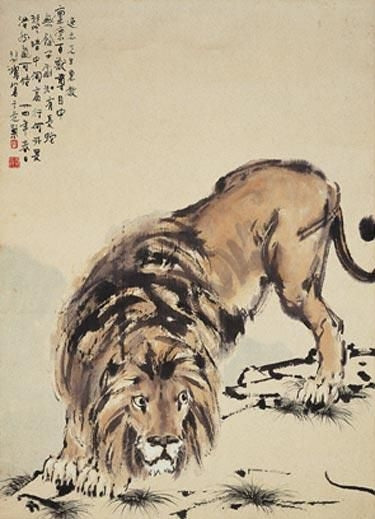Description
Xu Beihong, an iconic Chinese art figure, is distinguished by its ability in the combination of traditional Chinese techniques with western influences, creating works of an unprecedented depth. "Lion AGACHADO" (Crouching Lion) is an eloquent testimony of this artistic synthesis and reflects Beihong's mastery in the representation of the force contained and latent tension.
This work, created with paper ink, exhibits a lion in a crouched posture, clearly in a state of alert or stalking. The image, defined with safe and dynamic strokes, captures the power and grace of the animal, a recurrent symbol of force in many cultures. Beihong manages to transmit the sensation of immediacy and vitality of the lion, causing the viewer to almost feel latent energy about to unleash. The contours of the lion are drawn with a fluidity that reveals the artist's skill in the Chinese calligraphy domain, where each line is loaded with meaning and precision.
A remarkable aspect of "crouching lion" is its color economy. The work is mainly held in the use of black, with varied ink intensities that create a game of lights and shadows. This technique, known as 'MO', is a distinctive characteristic of traditional Chinese painting and requires exceptional control of the brush. The dark strokes vividly contrast with the empty space of the background, an aesthetic concept of the 'emptiness' or 'wu' that is essential in Chinese painting and that underlines the philosophy of Ying and Yang, where the full and empty is complemented each other .
The background of the painting is deliberately simple and minimalist, which is typical in many Beihong works. This treatment of negative space not only frames the lion, but also enhances it, allowing its powerful and dynamic form to be the absolute focus. It is in this simplicity where complexity resides; The empty space around the lion suggests a vast environment that does not need to be detailed to be felt, a reflection of aesthetic traditions where it is less.
Xu Beihong, born in 1895 and died in 1953, is known not only for his paintings of animals, but also because of its portraits and landscapes that combine elements of Western technique with the spiritual and philosophical depth of the Chinese tradition. He studied in Europe and was one of the first Chinese artists to assimilate and adapt the techniques of Western realism, admiring artists such as Jean-François Millet and Peter Paul Rubens. This convergence of styles is evident in "León Agachado", where the attention to the anatomical detail of the lion is found with a aesthetic sensitivity deeply rooted in the Chinese tradition.
It is relevant to mention that the lion, although it is not native to China, became an important cultural symbol through its association with imperial power and protection. In Beihong's work, the lion maintains its majesty, serving as a symbolic bridge between different cultural traditions and its own artistic and historical context.
In conclusion, "León Agracado" by Xu Beihong not only stands out for its technical execution, but also for its symbolic and cultural depth. Through a master combination of Chinese and Western traditional techniques, Beihong creates a work that is both a tribute to its cultural heritage and an innovative exploration of the ink potential on paper. This lion is not only a representation of animal power and grace, but also a testament of Beihong's ability to capture the essence of its object with a simple but powerful stroke of its brush.
KUADROS ©, a famous paint on your wall.
Hand-made oil painting reproductions, with the quality of professional artists and the distinctive seal of KUADROS ©.
Art reproduction service with satisfaction guarantee. If you are not completely satisfied with the replica of your painting, we refund your money 100%.

